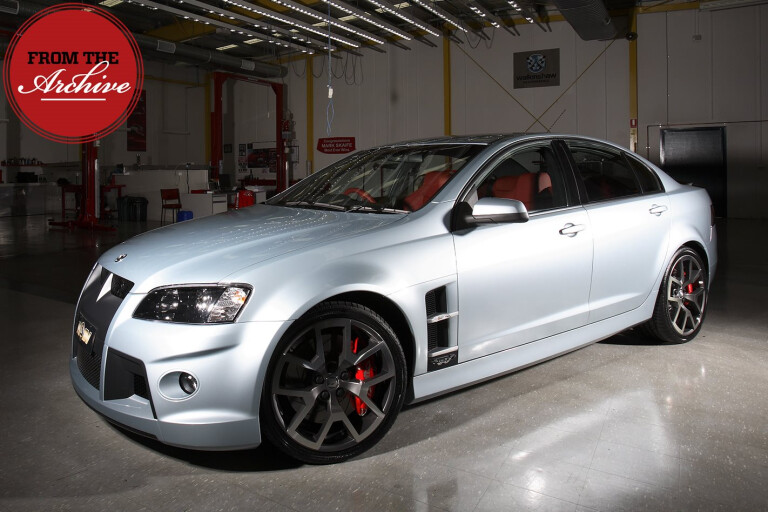
HSV’s 427 weapon lives again – but this time you’ll actually be able to buy one. Prepare for a fundamental shift in the performance playing field…
First published in the April 2008 issue of Wheels magazine, Australia’s most experienced and most trusted car magazine since 1953.
FORGET GT-HO Phase III, E38 Charger and GTS 350 Monaro – Australia has a new performance king. With its 370kW 7.0-litre V8, HSV’s W427 hammers every other locally-built muscle car and threatens to bloody the nose of European heavy hitters like BMW’s V10 M5 and Mercedes’ E63 AMG. With a claimed 0-100km/h time of 4.7-seconds it’ll have no problems running with the best European four-door super sedans.
“Since the original HRT 427 model [see breakout, right], the core of the company has wanted to do a supercar program,” explained HSV managing director Scott Grant. “There’s been that simmering of interest. Once E Series was established in the marketplace we could start thinking about this.”
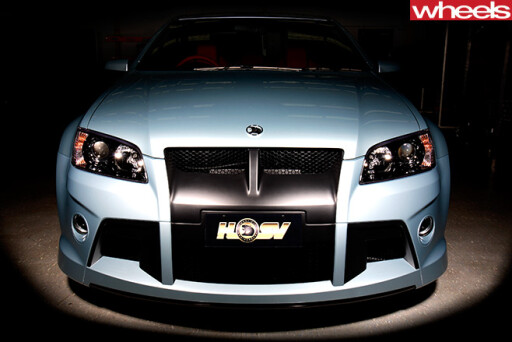 Like the HRT 427, the W427 is fitted with a 7.0-litre (or 427 cubic inch) V8 engine. Sourced from the Chevrolet Corvette Z06, the LS7 V8 produces 370kW and 640Nm – up 53kW and 90Nm over the 6.2-litre LS3 V8 that’s about to be launched across the rest of the HSV E Series range.
Like the HRT 427, the W427 is fitted with a 7.0-litre (or 427 cubic inch) V8 engine. Sourced from the Chevrolet Corvette Z06, the LS7 V8 produces 370kW and 640Nm – up 53kW and 90Nm over the 6.2-litre LS3 V8 that’s about to be launched across the rest of the HSV E Series range.
Unlike the stunning HRT concept, however, the W427 is destined for production in the third quarter of this year despite some mumblings from online conspiracy theorists that it could still go the way of the 2002 project.
HSV’s chief engineer Joel Stoddart is quick to shoot down such claims, “We wouldn’t have shown the car at Melbourne unless we could get it ADR certified. It’s passed the brake testing and we’ve just got to do emissions testing. There have been no big hurdles we had to get over for ADR.”
Stoddart’s confidence, however, does not mean the project was an easy one.
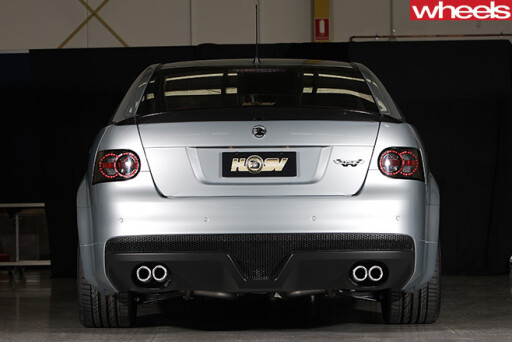 “The challenges were many,” says Stoddart. The LS7 engine is hand built at GM’s High Performance Build Center in Wixom, Michigan and is a road-going version of the engine that powers Chev’s Corvette C6.R Le Mans race car. Aside from the Z06 ’Vette, HSV’s W427 is the only car in the world to use this engine as standard fitment. With titanium con-rods and inlet valves, forged steel crankshaft and a dry sump lubrication system, the LS7 is as exotic as a BMW M5 V10 or Mercedes-Benz AMG V8.
“The challenges were many,” says Stoddart. The LS7 engine is hand built at GM’s High Performance Build Center in Wixom, Michigan and is a road-going version of the engine that powers Chev’s Corvette C6.R Le Mans race car. Aside from the Z06 ’Vette, HSV’s W427 is the only car in the world to use this engine as standard fitment. With titanium con-rods and inlet valves, forged steel crankshaft and a dry sump lubrication system, the LS7 is as exotic as a BMW M5 V10 or Mercedes-Benz AMG V8.
And it was this dry-sump system that caused the greatest headaches for the engineers.
“Locating the dry-sump catch can was a challenge,” explains Joel Stoddart. “Packaging that, plus a 13-row engine oil cooler in front of the radiator, meant we had to go for a Chevrolet Corvette-style over-the-radiator air-induction system.
“GM Powertrain is sensitive when you start changing oil systems,” he adds. “Lots of work was done with them on the best way to set it up and ensure we’re getting enough cooling.”
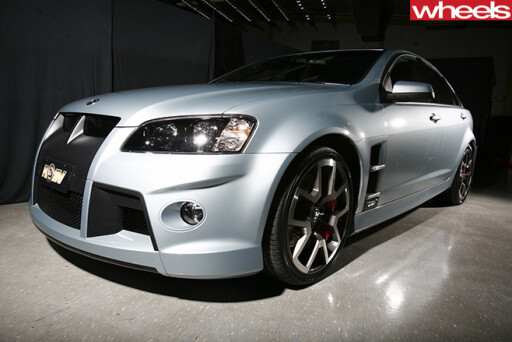 Because the LS7 is still part of the Gen IV family of V8s, and is physically no larger than the LS2 or LS3, the same engine mounts can be used. The shallower oil pan on the bottom of the V8 clears the Holden VE Commodore's front crossmember without modification, and the engine retains the ’Vette’s two-stage oil pump. As Stoddart puts it, “We don’t touch the bottom of the motor.”
Because the LS7 is still part of the Gen IV family of V8s, and is physically no larger than the LS2 or LS3, the same engine mounts can be used. The shallower oil pan on the bottom of the V8 clears the Holden VE Commodore's front crossmember without modification, and the engine retains the ’Vette’s two-stage oil pump. As Stoddart puts it, “We don’t touch the bottom of the motor.”
HSV couldn’t package the Corvette’s 4-into-1 manifold and instead designed a ceramic-coated 4-into-1 tubular 3-inch system for the W427.
“The headers are very different from the GTS and the rest of the system is 2.75-inch. A GTS uses a 2.25-inch. It’s a big exhaust,” says Stoddart.
The exhaust features active rear mufflers that, unlike most systems, don’t just rely on back pressure to open. Engine speed, vehicle speed and throttle position all determine whether the valves are open. At idle, for example, the valves open, but if you rev the engine with the car stationary, the valves snap shut.
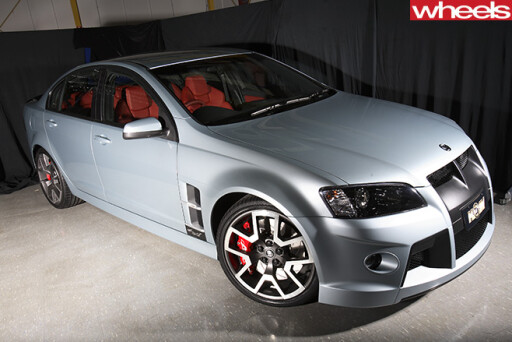 In the Chevrolet Corvette Z06, the LS7 produces 377kW at 6300rpm, 637Nm at 4800rpm and revs all the way to 7100rpm. Preliminary spec for the W427 suggests 370kW at 6500rpm and 640Nm at 5000rpm.
In the Chevrolet Corvette Z06, the LS7 produces 377kW at 6300rpm, 637Nm at 4800rpm and revs all the way to 7100rpm. Preliminary spec for the W427 suggests 370kW at 6500rpm and 640Nm at 5000rpm.
“We still haven’t set the rev limit,” explains Stoddart, “and it’ll be a call whether we want to let it rev to 7100rpm and what benefit there is. That’ll come in the final calibration. The final numbers are pretty close.”
Unlike the rest of the V8-engined HSV range, where the engines are line-fitted at Holden’s Elizabeth plant in South Australia, the LS7 will be installed at HSV’s HQ in the Melbourne suburb of Clayton.
“It’s not just the engine,” says Stoddart, “we’ve got the LS7 clutch, which needs a different pedal assembly because it’s a high clamp-load clutch. There’s also a different master cylinder. The plant’s not equipped for things like that in such small volumes.”
HSV can build around four cars per week and the program has an expected three-year life cycle, if demand justifies it.
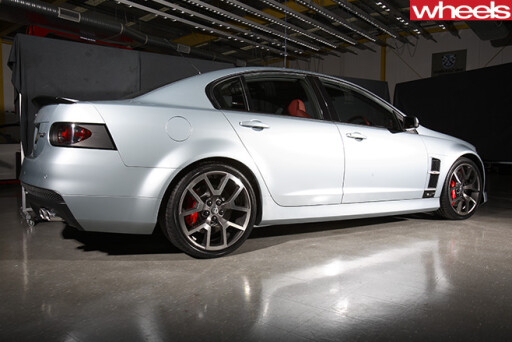 “With about 20 or 21 weeks of production this year,” says HSV boss Scott Grant, “we’ll build roughly 80 to 90 cars this year. And then we’ll go again next year. There will be far greater levels of demand than there will be production for some time. I suspect many customers will wait six months.”
“With about 20 or 21 weeks of production this year,” says HSV boss Scott Grant, “we’ll build roughly 80 to 90 cars this year. And then we’ll go again next year. There will be far greater levels of demand than there will be production for some time. I suspect many customers will wait six months.”
Backing the LS7 is a Tremec TR6060 M10 six-speed manual gearbox. The ratios are the same as the T56 manual in the GTS (except for a slightly shorter first gear), and the W427 retains the 3.70:1 final drive. The ZF differential features a carry-over casing, but HSV did extra work beefing up the internals including double shot-peening. The remainder of the drivetrain is as per GTS or Clubsport.
Like the Corvette Z06 there’s no automatic option for the W427, but Grant doesn’t see this limiting demand. “I think the type of buyer will appreciate the performance characteristics of the car with a manual,” he says.
The W427 sits 20mm lower than GTS and spring rates are 30 percent stiffer. HSV’s Magnetic Ride Control adjustable dampers (MRC) feature a W427-specific calibration.
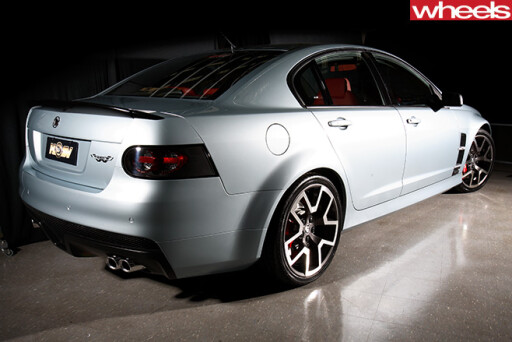 Stoddart says, “It’s a firm ride, but it’s not harsh. MRC is great because you can tune out the harshness.”
Stoddart says, “It’s a firm ride, but it’s not harsh. MRC is great because you can tune out the harshness.”
It’s the biggest engine ever fitted to an Aussie car and HSV has plumped for brakes to match. You’ll find huge 380mm slotted rotors at each end with massive six-piston, two-piece AP Racing calipers up front.
“It’s a fantastic brake package with great feel,” say Stoddart. By comparison the rest of the E Series range runs 365mm front rotors (350mm rears) with four-piston calipers.
At 208kg the LS7 engine weighs the same as the 6.0-litre LS2, so overall vehicle weight will increase by approximately only 10kg over a 1829kg manual GTS. This increase is attributed to the oil catch can, oil cooler and larger brakes. With 370kW, the 1840kg W427 has a 201kW-per-tonne power-to-weight ratio. Compare the 378kW/1840kg Mercedes-Benz E63 AMG (205kW/tonne) and BMW’s 373kW/1755kg M5 (213kW/tonne) and the W427 is easily in the ballpark.
And while HSV stops short of making a direct comparison with the aforementioned Euro super sedans, the BMW M5 comes up several times when discussing the design of the W427 with both Scott Grant and HSV’s chief of design and styling Julian Quincey.
 “Look at the BMW M5, it’s a terrific looking car,” say Grant, “The W427 is somewhat understated. Some of our earlier cars had interesting wings, but we didn’t feel it was appropriate with this sort of car.”
“Look at the BMW M5, it’s a terrific looking car,” say Grant, “The W427 is somewhat understated. Some of our earlier cars had interesting wings, but we didn’t feel it was appropriate with this sort of car.”
With an estimated sale price starting north of $130,000, Grant highlights, “that type of buyer is likely to be 40-plus and not everyone wants an ostentatious vehicle.”
The challenge for designer Julian Quincey was to give the W427 a unique look within the constraints of a very tight budget. The design budget was around 10 percent of the $4million total project cost and, as the project came after E Series was finalised, Quincey was limited in what he could physically change on the car.
“We started work on the clay of W427 in November 2006,” explains Quincey, “but the first E Series sketch was Feb 2003 with the first clay in July ’04.”
“We didn’t hold back with the E Series with a view that there’d be a 7.0-litre car later,” continues Quincey. “When it came to the 7.0-litre we wanted to make sure we clearly differentiated between the two cars.”
And while HSV claims to be happy with public reaction to the W427 (500 expressions of interest were registered the weekend after the show reveal), plenty of online enthusiast websites overflowed with negative comments about the new front fascia.
 “Some people out there are probably a bit surprised by the different face,” acknowledges Quincey. “It’s bold but not done in a bold way. It gives it a certain classy and expensive feel.”
“Some people out there are probably a bit surprised by the different face,” acknowledges Quincey. “It’s bold but not done in a bold way. It gives it a certain classy and expensive feel.”
Aside from needing to highlight a clear distinction as the range topper, the W427’s front fascia also needed to provide sufficient cooling for the LS7 engine. For example, different meshes were trialed to ensure correct air flow rates.
“On the show car we have a W427 badge inset into the grille [not shown in these pre-show photos],” says Quincey, “but it’s very much in the balance as to whether that stays, such are the cooling requirements of the engine.”
The rear deck lid is topped by a subtle carbonfibre lip spoiler that, according to Quincey, gives the W427, “a bespoke quality all of its own”.
“We felt a discreet rear spoiler was appropriate,” he says, “but if we got a big slap on the wrist [from public reaction] we’d do a bigger wing. So far, reaction has been positive.”
The only other exterior changes over a GTS are the W427-specific 20-inch alloys and a new set of machined quad exhaust tips.
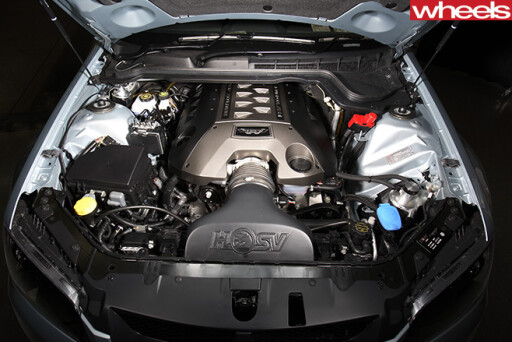 Juxtaposed against the understated exterior design is a vivid red interior. “We had three options with the interior: black, red or light urban [tan],” claims Quincey. “We felt red was something we could get away with on this vehicle.”
Juxtaposed against the understated exterior design is a vivid red interior. “We had three options with the interior: black, red or light urban [tan],” claims Quincey. “We felt red was something we could get away with on this vehicle.”
And according to Quincey, the red is not a show special. “Our current position is that red will be the only interior colour and we’ll be selecting exterior colours to go with that.”
The show car wore Panorama Silver as a nod to the 1988 VL Walkinshaw but this will not be a production option. Instead, think white, silver, red and black.
Just who will buy a $130K-plus HSV? The brand confidently anticipates that these customers will be both traditional HSV buyers and conquests from European marques. According to Scott Grant, “something like 15 percent of all E Series sales have been conquests from European brands. In some case people are trading BMWs and Porsches, which we’ve not seen in the previous 18 years of operating.”
Aside from the home market, the W427 will make its way across the ditch to New Zealand, but at this stage there are no exports plans for the UK or Middle East. Grant concedes, however, “that doesn’t mean something may not materialise over time.”
Without a great deal of chest-beating, HSV is justifiably proud of having finally brought a 7.0-litre program to life. The final word goes to chief engineer Joel Stoddart. “We just went out to build the best car we can. And now we’ll just have to see how it’ll stack up.”

COMMENTS